数据通信与网络答案20
数据通信与计算机网络考试试题及答案
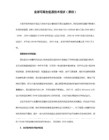
20、OSI七层参考模型是由( )来制定的 (正确答案:A 提交答案:A 判题:√ 得分:2分)
A、ISO B、IEEE C、ITU-T D、CCITT
21、下列不属于路由选择协议的是( ) (正确答案:B 提交答案:A 判题:╳ 得分:0分)
12、在计算机网络中,一般局域网的数据传输速率要比广域网的数据传输速率( ) (正确答案:A 提交答案: 判题:╳ 得分:0分)
A、高 B、低 C、相同 D、不确定
13、某部门申请到一个C类IP地址,若要分成8个子网,其掩码应为( )。 (正确答案:C 提交答案: 判题:╳ 得分:0分)
11、学校内的一个计算机网络系统,属于( ) (正确答案:B 提交答案:A 判题:╳ 得分:0分)
A、PAN B、LAN C、MAN D、WAN
12、服务与协议是完全不同的两个概念,下列关于它们的说法错误的是( ) (正确答案:D 提交答案:A 判题:╳ 得分:0分)
A、是通信技术与计算机技术结合的产物 B、是由计算机与传输介质组成的硬件系统 C、组建计算机网络目的是共享硬件、软件与数据 D、通信双方应遵循一定的规则与时序
10、完成路径选择功能是在OSI模型的( ) (正确答案:C 提交答案:A 判题:╳ 得分:0分)
A、物理层 B、数据链路层 C、网络层 D、运输层
A、x6+x4+x3+1 B、 x5+x3+x2+1 C、x5+x3+x2+x D、x6+x5+x4+1
17、100base-T使用的传输介质是( ) (正确答案:B 提交答案: 判题:╳ 得分:0分)
计算机通信与网络_习题答案

第二章习题解答2.01 试给出数据通信系统的基本模型并说明其主要组成构件的作用。
答:1)信源和信宿信源就是信息的发送端,是发出待传送信息的设备;信宿就是信息的接收端,是接收所传送信息的设备,在实际应用中,大部分信源和信宿设备都是计算机或其他数据终端设备(data terminal eq ui pment,DTE)。
2)信道信道是通信双方以传输媒体为基础的传输信息的通道,它是建立在通信线路及其附属设备(如收发设备)上的。
该定义似乎与传输媒体一样,但实际上两者并不完全相同。
一条通信介质构成的线路上往往可包含多个信道。
信道本身也可以是模拟的或数字方式的,用以传输模拟信号的信道叫做模拟信道,用以传输数字信号的信道叫做数字信道。
3)信号转换设备其作用是将信源发出的信息转换成适合于在信道上传输的信号,对应不同的信源和信道,信号转换设备有不同的组成和变换功能。
发送端的信号转换设备可以是编码器或调制器,接收端的信号转换设备相对应的就是译码器或解调器。
2.02 试解释以下名词:数据,信号,模拟数据,模拟信号,数字数据,数字信号。
答:数据:通常是指预先约定的具有某种含义的数字、符号和字母的组合。
信号:信号是数据在传输过程中的电磁波的表示形式。
模拟数据:取值是连续的数据。
模拟信号:是指幅度随时间连续变化的信号。
数字数据:取值是离散的数据。
数字信号:时间上是不连续的、离散性的信号2.03 什么叫传信速率?什么叫传码速率?说明两者的不同与关系。
答:传信速率又称为比特率,记作R b,是指在数据通信系统中,每秒钟传输二进制码元的个数,单位是比特/秒(bit/s,或kbit/s或Mbit/s)。
传码速率又称为调制速率、波特率,记作N Bd,是指在数据通信系统中,每秒钟传输信号码元的个数,单位是波特(Baud)。
若是二电平传输,则在一个信号码元中包含一个二进制码元,即二者在数值上是相等的;若是多电平(M电平)传输,则二者在数值上有R b=N Bd×log2 M的关系。
数据通信与计算机网络试卷及答案
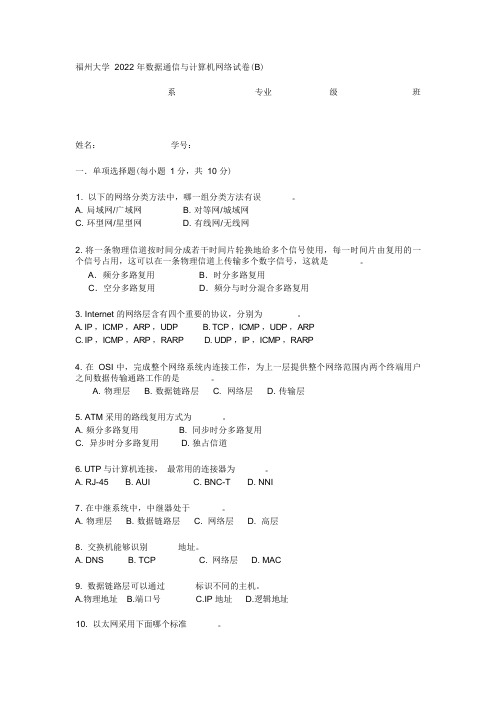
福州大学2022 年数据通信与计算机网络试卷(B)系专业级班姓名:学号:一.单项选择题(每小题 1 分,共10 分)1. 以下的网络分类方法中,哪一组分类方法有误。
A. 局域网/广域网B. 对等网/城域网C. 环型网/星型网D. 有线网/无线网2. 将一条物理信道按时间分成若干时间片轮换地给多个信号使用,每一时间片由复用的一个信号占用,这可以在一条物理信道上传输多个数字信号,这就是。
A.频分多路复用B.时分多路复用C.空分多路复用D.频分与时分混合多路复用3. Internet 的网络层含有四个重要的协议,分别为。
A. IP ,ICMP ,ARP ,UDPB. TCP ,ICMP ,UDP ,ARPC. IP ,ICMP ,ARP ,RARPD. UDP ,IP ,ICMP ,RARP4. 在OSI 中,完成整个网络系统内连接工作,为上一层提供整个网络范围内两个终端用户之间数据传输通路工作的是。
A. 物理层B. 数据链路层C. 网络层D. 传输层5. ATM 采用的路线复用方式为。
A. 频分多路复用B. 同步时分多路复用C. 异步时分多路复用D. 独占信道6. UTP 与计算机连接,最常用的连接器为。
A. RJ-45B. AUIC. BNC-TD. NNI7. 在中继系统中,中继器处于。
A. 物理层B. 数据链路层C. 网络层D. 高层8. 交换机能够识别地址。
A. DNSB. TCPC. 网络层D. MAC9. 数据链路层可以通过标识不同的主机。
A.物理地址B.端口号C.IP 地址D.逻辑地址10. 以太网采用下面哪个标准。
A. IEEE802.3B. IEEE802.4C. IEEE802.5D. Token Ring二.填空题(每空1 分,共10 分)1.在下列每一特征前面的空白处标出该特征所描述的是局域网(LAN)还是广域网(WAN)?通常使用广播技术来替代存储转发的路由选择;通常为一个单位拥有;限制条件是传输通道的速率。
最新第二章-数据通信基础-习题与答案

第二章数据通信基础习题与答案一、判断题1.(√)计算机中的信息都是用数字形式来表示的。
2.(√)信道容量是指信道传输信息的最大能力,通常用信息速率来表示,单位时间内传送的比特数越多,表示信道容量越大。
3.(×)波特率是指信息传输的错误率,是数据通信系统在正常工作情况下,衡量传输可靠性的指标。
4.(×)在单信道总线型网络中,带宽=信道容量×传输效率。
5.(√)在共享信道型的局域网中,信号的传播延迟或时延的大小与采用哪种网络技术有很大关系。
6.(√)DTE是指用于处理用户数据的设备,是数据通信系统的信源和住宿。
7.(√)DCE是数据通信设备,是介于数据终端设备与传输介质之间的设备。
8.(×)Modem属于DTE。
9.(√)在单工通信的两个节点中,其中一端只能作为发送端发送数据不能接收数据,另一端只能接收数据不能发送数据。
10.(√)在半双工通信的双方可以交替地发送和接收信息,不能同时发送和接收,只需要一条传输线路即可。
11.(×)在全双工通信的双方可以同时进行信息的发送与接收,只需要一条传输线路即可。
12.(√)在局域网中,主要采用的是基带数据传输方式。
13.(√)信道带宽的单位是赫兹。
14.(×)数据通信系统主要技术指标中的信道容量=吞吐量×传输效率。
15.(×)比特率和波特率是两个相同的概念。
16.(√)基带传输与宽带传输的主要区别在于数据传输速率不同。
17.(√)分组交换是以长度受到限制的报文分组为单位进行传输交换的。
18.(√)电路交换有建立连接、传输数据和拆除连接三个通信过程。
19.(√)分组交换比电路交换线路利用率高,但实时性差。
20.(√)ATM(即异步传输模式)是一种广域网主干线常采用的技术。
21.(√)数据传输率是指单位时间内信道内传输的信息量,即比特率。
22.(×)使用调制解调器进行网络数据传输称为基带传输。
数据通信与计算机网络复习题与答案全
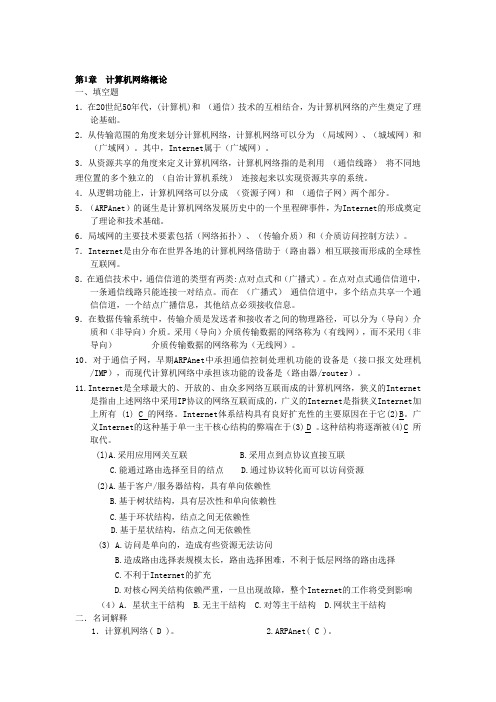
第1章计算机网络概论一、填空题1.在20世纪50年代,(计算机)和(通信)技术的互相结合,为计算机网络的产生奠定了理论基础。
2.从传输范围的角度来划分计算机网络,计算机网络可以分为(局域网)、(城域网)和(广域网)。
其中,Internet属于(广域网)。
3.从资源共享的角度来定义计算机网络,计算机网络指的是利用(通信线路)将不同地理位置的多个独立的(自治计算机系统)连接起来以实现资源共享的系统。
4.从逻辑功能上,计算机网络可以分成(资源子网)和(通信子网)两个部分。
5.(ARPAnet)的诞生是计算机网络发展历史中的一个里程碑事件,为Internet的形成奠定了理论和技术基础。
6.局域网的主要技术要素包括(网络拓扑)、(传输介质)和(介质访问控制方法)。
7.Internet是由分布在世界各地的计算机网络借助于(路由器)相互联接而形成的全球性互联网。
8.在通信技术中,通信信道的类型有两类:点对点式和(广播式)。
在点对点式通信信道中,一条通信线路只能连接一对结点。
而在(广播式)通信信道中,多个结点共享一个通信信道,一个结点广播信息,其他结点必须接收信息。
9.在数据传输系统中,传输介质是发送者和接收者之间的物理路径,可以分为(导向)介质和(非导向)介质。
采用(导向)介质传输数据的网络称为(有线网),而不采用(非导向)介质传输数据的网络称为(无线网)。
10.对于通信子网,早期ARPAnet中承担通信控制处理机功能的设备是(接口报文处理机/IMP),而现代计算机网络中承担该功能的设备是(路由器/router)。
11.Internet是全球最大的、开放的、由众多网络互联而成的计算机网络,狭义的Internet是指由上述网络中采用IP协议的网络互联而成的,广义的Internet是指狭义Internet加上所有 (1) C 的网络。
Internet体系结构具有良好扩充性的主要原因在于它(2)B。
广义Internet的这种基于单一主干核心结构的弊端在于(3) D 。
数据通信与网络基础参考答案(可编辑)

数据通信与网络基础参考答案习题参考答案第一讲(1)通信基本概念利用电磁波通信的历史分为哪几个阶段,标志每个阶段开始的技术或成果是什么?对每个阶段各列举三个重要的贡献。
解答通信历史的划分有着不同的方法。
有人把利用电磁波通信的历史划分为三个阶段。
通信初级阶段该阶段始于摩尔斯发明电报的19世纪30年代,奠定了通信技术的发展基础。
19世纪70年代,贝尔利用电磁感应原理发明了电话机。
使电磁波不仅可传输文字,还可传输语音,加快了通信发展进程,丰富了通信的内容。
在此基础上建立的电话通信网络不断演变,是今天语音通信乃至数据通信的重要基础设施。
1864年麦克斯韦创立了电磁辐射理论,并被同时代的赫兹加以证明,促成马可尼在19世纪末发明出简单的无线电收发信设备,开创了无线电通信事业。
无线电广播、电视、雷达、微波及卫星通信、蜂窝电话等正是在此基础上得到发明和应用。
近代通信阶段1948年香农提出了信息论, 建立了通信统计理论,标志着近代通信的开始。
从1958年发射了人类的第一颗通信卫星起,各种轨道和各种用途的卫星相继问世。
为全球性通信尤其是移动通信提供了便利。
数据通信业务的开展与计算机网络的出现,使为信息时代的到来奠定了基础。
现代通信阶段该阶段从20世纪80年代算起,通信逐步向数字化演进。
公用数字通信业务的展开,计算机网络技术长足进步(网络体系结构的标准化,局域网的问世与普及,Internet的广泛应用),移动通信大众化是这个阶段的主要成就。
根据围绕地球运行的轨道的不同,通信卫星可分为哪几类?试述各类的特征和主要特点。
解答人造地球卫星根据相对于地球的运行轨迹分为以下几种。
同步地球轨道卫星 (GEO)运行于近赤道的轨道上,通常高度约36000千米,因与地球自转同步,因此相对于地球是静止的,所以也称为固定卫星系统,原理上最少三颗卫星可实现全球通信。
通信需要大功率的发射装置,其接收装置体积也较大。
主要用于语音和较低速率的数据通信。
数据通信与计算机网络(第二版)-作业答案
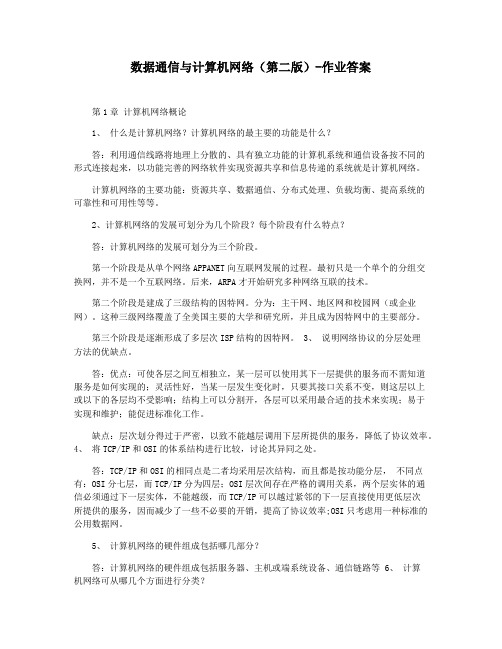
数据通信与计算机网络(第二版)-作业答案第1章计算机网络概论1、什么是计算机网络?计算机网络的最主要的功能是什么?答:利用通信线路将地理上分散的、具有独立功能的计算机系统和通信设备按不同的形式连接起来,以功能完善的网络软件实现资源共享和信息传递的系统就是计算机网络。
计算机网络的主要功能:资源共享、数据通信、分布式处理、负载均衡、提高系统的可靠性和可用性等等。
2、计算机网络的发展可划分为几个阶段?每个阶段有什么特点?答:计算机网络的发展可划分为三个阶段。
第一个阶段是从单个网络APPANET向互联网发展的过程。
最初只是一个单个的分组交换网,并不是一个互联网络。
后来,ARPA才开始研究多种网络互联的技术。
第二个阶段是建成了三级结构的因特网。
分为:主干网、地区网和校园网(或企业网)。
这种三级网络覆盖了全美国主要的大学和研究所,并且成为因特网中的主要部分。
第三个阶段是逐渐形成了多层次ISP结构的因特网。
3、说明网络协议的分层处理方法的优缺点。
答:优点:可使各层之间互相独立,某一层可以使用其下一层提供的服务而不需知道服务是如何实现的;灵活性好,当某一层发生变化时,只要其接口关系不变,则这层以上或以下的各层均不受影响;结构上可以分割开,各层可以采用最合适的技术来实现;易于实现和维护;能促进标准化工作。
缺点:层次划分得过于严密,以致不能越层调用下层所提供的服务,降低了协议效率。
4、将TCP/IP和OSI的体系结构进行比较,讨论其异同之处。
答:TCP/IP和OSI的相同点是二者均采用层次结构,而且都是按功能分层,不同点有:OSI分七层,而TCP/IP分为四层;OSI层次间存在严格的调用关系,两个层实体的通信必须通过下一层实体,不能越级,而TCP/IP可以越过紧邻的下一层直接使用更低层次所提供的服务,因而减少了一些不必要的开销,提高了协议效率;OSI只考虑用一种标准的公用数据网。
5、计算机网络的硬件组成包括哪几部分?答:计算机网络的硬件组成包括服务器、主机或端系统设备、通信链路等 6、计算机网络可从哪几个方面进行分类?答:计算机网络可以从网络的交换功能、网络的拓扑结构、网络的覆盖范围、网络的使用范围等方面进行分类。
数据通信网课后题答案 第一章-第五章
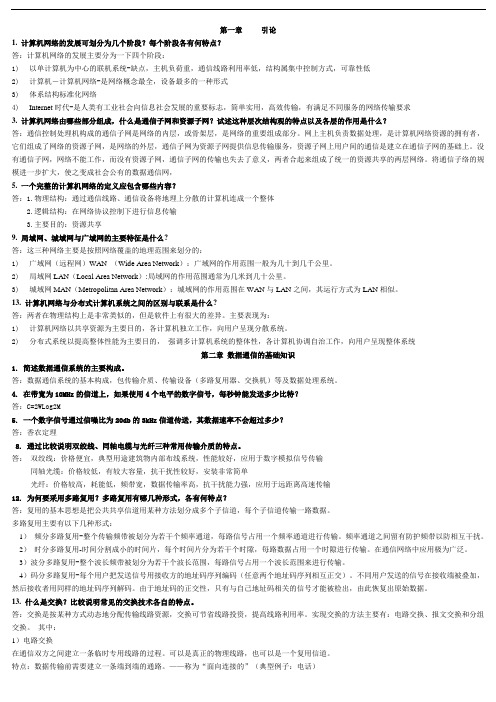
第一章引论1. 计算机网络的发展可划分为几个阶段?每个阶段各有何特点?答:计算机网络的发展主要分为一下四个阶段:1)以单计算机为中心的联机系统-缺点,主机负荷重,通信线路利用率低,结构属集中控制方式,可靠性低2)计算机-计算机网络-是网络概念最全,设备最多的一种形式3)体系结构标准化网络4)Internet时代-是人类有工业社会向信息社会发展的重要标志,简单实用,高效传输,有满足不同服务的网络传输要求3. 计算机网络由哪些部分组成,什么是通信子网和资源子网?试述这种层次结构观的特点以及各层的作用是什么?答:通信控制处理机构成的通信子网是网络的内层,或骨架层,是网络的重要组成部分。
网上主机负责数据处理,是计算机网络资源的拥有者,它们组成了网络的资源子网,是网络的外层,通信子网为资源子网提供信息传输服务,资源子网上用户间的通信是建立在通信子网的基础上。
没有通信子网,网络不能工作,而没有资源子网,通信子网的传输也失去了意义,两者合起来组成了统一的资源共享的两层网络。
将通信子络的规模进一步扩大,使之变成社会公有的数据通信网,5. 一个完整的计算机网络的定义应包含哪些内容?答:1.物理结构:通过通信线路、通信设备将地理上分散的计算机连成一个整体2.逻辑结构:在网络协议控制下进行信息传输3.主要目的:资源共享9. 局域网、城域网与广域网的主要特征是什么?答:这三种网络主要是按照网络覆盖的地理范围来划分的:1)广域网(远程网)WAN (Wide Area Network):广域网的作用范围一般为几十到几千公里。
2)局域网LAN(Local Area Network):局域网的作用范围通常为几米到几十公里。
3)城域网MAN(Metropolitan Area Network):城域网的作用范围在WAN与LAN之间,其运行方式为LAN相似。
13. 计算机网络与分布式计算机系统之间的区别与联系是什么?答:两者在物理结构上是非常类似的,但是软件上有很大的差异。
数据通信与网络技术1已备注答案

1、在OSI的_ C __使用的互联设备是路由器。
A、物理层B、数据链路层C、网络层D、传输层2、某数据的7位编码为0110101,若在其中最高位之前增加一位偶校验位,则编码为00110110 。
A.10110101 B.00110101 C.01101011 D.011010103、通常在光纤传输中使用的多路复用技术是 A 。
A.WDM B.TDM C.CDMA D.STDM4、在局域网模型中,数据链路层分为 A 。
A.逻辑链路控制子层和网络子层B.逻辑链路控制子层和媒体访问控制子层C.网络接口访问控制子层和媒体访问控制子层D.逻辑链路控制子层和网络接口访问控制子层5、在ATM网络中数据交换的单位是_ B __。
A、信宿B、信元C、信源D、分组6、在ISO OSI/RM中, B 实现数据压缩功能。
A.应用层B.表示层C.会话层D.网络层7、IP地址10000101 00110100 00000000 10001111的十进制写法是__ C __。
A、90.43.0.15B、129.62.0.143C、133.52.0.143D、90.3.96.448、FTP指的是__ C __。
A. 万维网B. 电子邮件C. 文件传输D. 远程登录9、一个IP地址VLSM表示的方法为169.178.57.100/28,则此IP地址的子网掩码为_D__ 。
A、255.255.255.0B、255.255.0.0C、255.255.224.0D、255.255.255.24010、以太网中的帧属于 B 协议数据单元。
A.物理层B.数据链路层C.网络层D.应用层11、将物理地址转换为IP地址的协议是__ D _。
A、IPB、ICMPC、ARPD、RARP12、与多模光纤相比较,单模光纤具有 A 等特点。
A. 较高的传输率、较长的传输距离、较高的成本B. 较低的传输率、较短的传输距离、较高的成本C. 较高的传输率、较短的传输距离、较低的成本D. 较低的传输率、较长的传输距离、较低的成本13、一个局域网中某台主机的IP地址为176.68.160.12,使用22位作为网络地址,那么该局域网最多可以连接的主机数为 C 。
数据通信原理习题与答案
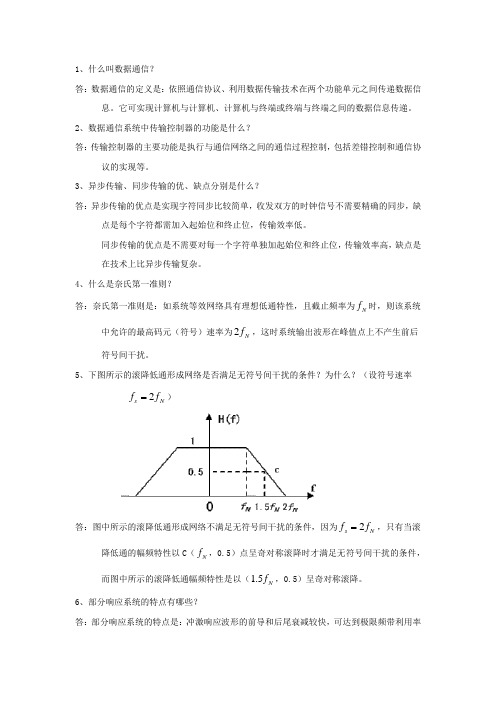
1、什么叫数据通信?答:数据通信的定义是:依照通信协议、利用数据传输技术在两个功能单元之间传递数据信息。
它可实现计算机与计算机、计算机与终端或终端与终端之间的数据信息传递。
2、数据通信系统中传输控制器的功能是什么?答:传输控制器的主要功能是执行与通信网络之间的通信过程控制,包括差错控制和通信协议的实现等。
3、异步传输、同步传输的优、缺点分别是什么?答:异步传输的优点是实现字符同步比较简单,收发双方的时钟信号不需要精确的同步,缺点是每个字符都需加入起始位和终止位,传输效率低。
同步传输的优点是不需要对每一个字符单独加起始位和终止位,传输效率高,缺点是在技术上比异步传输复杂。
4、什么是奈氏第一准则?答:奈氏第一准则是:如系统等效网络具有理想低通特性,且截止频率为N f 时,则该系统中允许的最高码元(符号)速率为N f 2,这时系统输出波形在峰值点上不产生前后符号间干扰。
5、下图所示的滚降低通形成网络是否满足无符号间干扰的条件?为什么?(设符号速率N s f f 2=)答:图中所示的滚降低通形成网络不满足无符号间干扰的条件,因为N s f f 2=,只有当滚降低通的幅频特性以C (N f ,0.5)点呈奇对称滚降时才满足无符号间干扰的条件,而图中所示的滚降低通幅频特性是以(N f 5.1,0.5)呈奇对称滚降。
6、部分响应系统的特点有哪些?答:部分响应系统的特点是:冲激响应波形的前导和后尾衰减较快,可达到极限频带利用率2,并且物理上可实现,但有符号间干扰,该符号间干扰是固定的,可以消Bd/Hz除的。
7、基带传输时域均衡的作用是什么?答:尽管在设计基带形成滤波器时是按照奈氏第一准则的要求,但如果信道特性发生畸变,会使形成滤波器的传递函数H(f)改变,其冲激响应波形有可能会产生符号间干扰。
时域均衡器的作用就是消除符号间干扰,即使得时域均衡器的输出波形满足无符号间干扰的条件。
8、频带传输系统中收端低通的作用是什么?答:频带传输系统中收端低通的作用是除去解调中出现的高次产物并起基带波形形成的功能。
数据通信与计算机网络答案

(1)根桥是桥ID最小的桥,因此根桥为B1,当生 成树形成后,B1的J、K,B4的I,B6的P, B2的D,B3、B5和B7没有根端口。
4.37 下图给出了一个通过网桥连接的LAN拓扑,每个链路的值表示该链 路的花费,请给出对应的生成树。假设桥1关机,请问现在生成树又是怎 样?
LAN1
LAN2
7.43 把一个1024字节的IP分组划分为若干个分段,各分段要 通过一个分组最大长度为128字节的X.25网络,问需要多少个 分段?不计更地层的开销,仅考虑X.25和IP分组的开销,传输效 率是多少?
答:X.25的分组可以分为数据分组和控制分组两种,它们都有一个公共的部 分即分组头,它由3个字节构成。
2007年9月19日作业
3.35 若某面向字符同步规程的帧数据段中出现下列字符串,问字符填充后的输 出是什么? A DLE STX B C DLE DLE DLE DLE ETB 答案: A DLE DLE STX B C DLE DLE DLE DLE DLE DLE DLE ETB 3.36 若某面向比特同步规程的帧数据段中出现下列位串,问比特填充后输出是 什么? 0100000111110101111110 答案:参看P106 010000011111001011111010 3.37 某PPP帧的信息部分为十六进制7C 7D 5E 5D 69 3A 7D 5D 7D 5D 6A 5D, 问其原始信息是啥? 答案: 7C F 5D 69 3A 7D 7D 6A 5D
所需分段数:1024/104=9.85,第1到9个分组 为127个字节,第10个分组长度为111个字 节。 传输效率:1024/(9*127+111) =1024/1254=81.65%
2007年10月24日作业
北交20新上《数据通信与计算机网络》在线作业2_49188

(单选题)1: 在Internet网上,军事机构网址的后缀一般为()。
A: Com
B: org
C: net
D: mil
正确答案: D
(单选题)2: 以下各项中,不是数据报操作特点的是()。
A: 每个分组自身携带有足够的信息,它的传送是被单独处理的
B: 在整个传送过程中,不需建立虚电路
C: 使所有分组按顺序到达目的端系统
D: 网络节点要为每个分组做出路由选择
正确答案: C
(单选题)3: ATM技术的特点是()。
A: 网状拓朴
B: 以信元为数据传输单位
C: 以帧为数据传输单位
D: 同步传输
正确答案: B
(单选题)4: 令牌环(Token Ring)的访问方法和物理技术规范由()描述。
A: IEEE802.2
B: IEEE802.3
C: IEEE802.4
D: IEEE802.5
正确答案: D
(单选题)5: 网络层的互联设备是()。
A: 网桥
B: 交换机
C: 路由器
D: 网关
正确答案: C
(单选题)6: 在Internet网上采用的网络协议是()。
A: IPX/SPX
B: X.25协议
C: TCP/IP协议
D: LLC协议
正确答案: D
(单选题)7: 网桥是用于哪一层的设备()。
A: 物理层。
数据通信基础 习题与答案

第二章数据通信基础习题与答案一、判断题1.(√)计算机中的信息都是用数字形式来表示的。
2.(√)信道容量是指信道传输信息的最大能力,通常用信息速率来表示,单位时间内传送的比特数越多,表示信道容量越大。
3.(×)波特率是指信息传输的错误率,是数据通信系统在正常工作情况下,衡量传输可靠性的指标。
4.(×)在单信道总线型网络中,带宽=信道容量×传输效率。
5.(√)在共享信道型的局域网中,信号的传播延迟或时延的大小与采用哪种网络技术有很大关系。
6.(√)DTE是指用于处理用户数据的设备,是数据通信系统的信源和住宿。
7.(√)DCE是数据通信设备,是介于数据终端设备与传输介质之间的设备。
8.(×)Modem属于DTE。
9.(√)在单工通信的两个节点中,其中一端只能作为发送端发送数据不能接收数据,另一端只能接收数据不能发送数据。
10.(√)在半双工通信的双方可以交替地发送和接收信息,不能同时发送和接收,只需要一条传输线路即可。
11.(×)在全双工通信的双方可以同时进行信息的发送与接收,只需要一条传输线路即可。
12.(√)在局域网中,主要采用的是基带数据传输方式。
13.(√)信道带宽的单位是赫兹。
14.(×)数据通信系统主要技术指标中的信道容量=吞吐量×传输效率。
15.(×)比特率和波特率是两个相同的概念。
16.(√)基带传输与宽带传输的主要区别在于数据传输速率不同。
17.(√)分组交换是以长度受到限制的报文分组为单位进行传输交换的。
18.(√)电路交换有建立连接、传输数据和拆除连接三个通信过程。
19.(√)分组交换比电路交换线路利用率高,但实时性差。
20.(√)ATM(即异步传输模式)是一种广域网主干线常采用的技术。
21.(√)数据传输率是指单位时间内信道内传输的信息量,即比特率。
22.(×)使用调制解调器进行网络数据传输称为基带传输。
第二章 数据通信基础 习题与答案

第二章数据通信基础习题与答案一、判断题1、( √)计算机中的信息都就是用数字形式来表示的。
2、( √)信道容量就是指信道传输信息的最大能力,通常用信息速率来表示,单位时间内传送的比特数越多,表示信道容量越大。
3、( ×)波特率就是指信息传输的错误率,就是数据通信系统在正常工作情况下,衡量传输可靠性的指标。
4、( ×)在单信道总线型网络中,带宽=信道容量×传输效率。
5、( √)在共享信道型的局域网中,信号的传播延迟或时延的大小与采用哪种网络技术有很大关系。
6、( √)DTE就是指用于处理用户数据的设备,就是数据通信系统的信源与住宿。
7、( √)DCE就是数据通信设备,就是介于数据终端设备与传输介质之间的设备。
8、( ×)Modem属于DTE。
9、( √)在单工通信的两个节点中,其中一端只能作为发送端发送数据不能接收数据,另一端只能接收数据不能发送数据。
10、( √)在半双工通信的双方可以交替地发送与接收信息,不能同时发送与接收,只需要一条传输线路即可。
11、( ×)在全双工通信的双方可以同时进行信息的发送与接收,只需要一条传输线路即可。
12、( √)在局域网中,主要采用的就是基带数据传输方式。
13.( √)信道带宽的单位就是赫兹。
14.( ×)数据通信系统主要技术指标中的信道容量=吞吐量×传输效率。
15.( ×)比特率与波特率就是两个相同的概念。
16.( √)基带传输与宽带传输的主要区别在于数据传输速率不同。
17.( √)分组交换就是以长度受到限制的报文分组为单位进行传输交换的。
18.( √)电路交换有建立连接、传输数据与拆除连接三个通信过程。
19.( √)分组交换比电路交换线路利用率高,但实时性差。
20.( √)ATM(即异步传输模式)就是一种广域网主干线常采用的技术。
21.( √)数据传输率就是指单位时间内信道内传输的信息量,即比特率。
《数据通信与计算机网络》补充习题参考答案

《数据通信与计算机网络》补充题题介第一章1.计算机网络的发展经历了几个阶段?各阶段有什么特点?2.通信子网是计算机网络的一个组成部分。
试列出在计算机网络的工作中那些是由通信子网完成的?那些不是?3.简述可以从几种不同角度来对计算机网络分类。
第二章1. 在一个n 层的网络系统中,每层协议分别要求加上H i 字节长的报头。
若送往该网络的应用数据长度为A 字节,问在物理媒体的带宽中有多少百分比是用来传输有效应用数据的? 解: ∵每层协议要求加上H i 字节的报头 ∴n 层的网络系统中,增加的开销为∑=ni Hi 1 又∵ 应用数据长度为A 字节∴传输有效应用数据的有效的带宽占∑=+ni HiA A 1第三章1.简述通信系统的模型。
2.物理层协议包括哪四方面的内容?3.简述模拟数据及数字数据的模拟信号及数字信号表示方法。
4.简述MODEM 和CODEC 的作用。
5.什么是数据通信?6.数据传输速率与信号传输速率的单位各是什么?它们之间有什么关系?7.数据传输速率与信道容量的单位各是什么?它们之间有什么不同?8.对于带宽为4KHz 的信道,若用8种不同的物理状态来表示数据,信噪比为30db ,试问按奈奎斯特定理,最大限制的数据速率是多少?按香农定理最大限制的数据速率是多少? 解:按奈奎斯特定理 C = 2H ·log 2N∵N = 8,H = 4KHZ ∴C = 24 kbps 按香农定理, C = H ·log 2(1+S/N ) ∵信噪比为30db ,30db = 10· log S/N ∴ 100010/1030==N S H = 4KHZ∴C = H ·log 2(1+1000)= 40 kbps9.对于带宽为6MHz 的信道,若用4种不同的状态来表示数据,在不考虑热噪声的情况下,该信道的最大数据传输速率是多少?解:按奈奎斯特定理:C = 2·H ·log 2N ∵N = 4, H = 6MHZ∴C = 2·6MHZ ·log 24 = 24 Mbps10.某调制解调器同时使用幅移键控和相移键控,采用0、π/2、π和3/2π四种相位,每种相位又都有两个不同的幅度值,问波特率为1200的情况下数据速率是多少?同时使用幅移键控和相移键控 解:有πππ23,,2,0 4种相位,每个相位又有2个幅度∴N = 4×2 = 8 B = 1200 baud ∴S = B ·log 2N = 3600 bps11.信道带宽为3KHz ,信噪比为30db ,每个信号两种状态,则每秒能发送的比特数不会超过多少?解:按香农定理:信噪比为30db , H = 3KHZ∴ 1000101030==N SC = H ·log 2(1+1000) = 30 kbps 按奈奎斯特定理 C = 2H ·log 2N∵N = 2,H = 3KHZ ∴C = 6 kbps所以该信道每秒能发送的比特数不会超过6 kbit 。
计算机数据通信和网络模拟题一

计算机数据通信与网络模拟一一、单项选择题(本大题共20小题,每小题1分,共20分)1.为了提高公共数据网的数据吞吐率和传输速度,公共数据网最新采用的交换协议是A.X.25B.帧中继C.ATMD.FDDI2.PSK和ASK技术的结合可以提高数据传输速率,这种调制方式称为A.相位幅度调制PAMB.相位频率调制PFMC.频率幅度调制FAMD.频率相位调制FPM3.网络层的协议数据单元称作A.帧B.位C.分组D.报文4.TCP协议的全称是A.互连网协议B.传输控制协议C.数据报协议D.超文本协议5.TCP/IP协议簇中属于互连层协议的是A.TCPB.RARPC.DNSD.FTP6.串行通信线路的数据链路层协议中可以支持动态IP地址的是A.SLIPB.UDPC.PPPD.TCP7.IEEE802.3的CSMA/CD常用的退避算法是A.非坚持B.1-坚持C.P-坚持D.可预测P-坚持8.对于10Mbps的基带CSMA/CD网,在发生冲突时所产生的碎片帧的长度应小于A.64字节B.128字节C.256字节D.512字节9.在一栋楼的同一楼层内,要求用千兆以太网技术将一台服务器连接到楼层的接人交换机,二者之间的距离是78米,应采用的千兆以太网物理层协议是A.1000Base-SXB.1000Base-LXC.1000Base-CXD.1000Base-T10.在以下交换方式中传输延时最小,但线路利用率最低的是A.电路交换B.分组交换C.报文交换D.字符交换l1.对于大型企业,在用户设备和ISDN交换设备之间需要安装的设备是A.网络终端NTlB.网络终端NT2C.网络终端NTl+NT2D.调制解调器12.X.25网的交换节点所参与的OSI层次是A.1-4层B.1-3层C.1-2层D.1层13.ATM网的交换节点所参与的OSI层次是A.1-4层B.1-3层C.1-2层D.1层14.以下对ATM网络特征的描述错误..的是A.ATM仍然采用分组交换技术B.ATM网络节点只参与物理层功能C.ATM是面向连接的交换D.ATM不支持多媒体传输应用15.ATM网络所采用的复用方式为A.同步时分复用B.异步时分复用C.频分多路复用D.空分复用16.某住户通过小区以太网连接因特网,这种接入方式称为A.拨号IP方式B.仿真终端方式C.局域网连接方式D.无线接入方式17.因特网中无连接的用户数据报协议UDP对应于OSI的A.网络层B.传输层C.会话层D.应用层18.一个大网通过子网掩码分成若干子网,子网之间的连接设备可以是A.网关B.路由器C.转发器D.集线器19.一个网络标识为202.13.12的C类IP地址,掩码为255.255.255.224,与主机202.13.12.129在同一子网的是A.202.13.12.12B.202.13.12.34C.202.13.12.125D.202.13.12.15820.万维网WWW(World Wide Web)是Internet上的A.一个主页B.一个Web服务器C.一个网页D.全球信息资源网络非选择题部分二、填空题(本大题共20小题,每空1分,共20分)21.通过因特网向公众提供信息内容服务的公司或部门英文简称为______。
《数据通信与计算机网络(第4版)》杨心强编 课后习题参考答案

附录A 部分习题参考答案第 1 章1-11 在0.1μm 频段中的带宽为30000GHz 。
1-121-13 网络最小时延就是网络的空闲时延。
当前网络时延是它的最小时延的5倍。
1-14 ①传输时延是100s ,传播时延是5ms ,此时传输时延远大于传播时延。
②传输时延是1μs ,传播时延是5ms ,此时传输时延远小于传播时延。
1-17 ①用户数据的长度为100字节时,以太网的帧长为178字节,在物理层形成的比特流的长度是186字节,此时的数据传输效率为53.8%②用户数据的长度为1000字节时,以太网的帧长为1078字节,在物理层形成的比特流的长度是1086字节,此时的数据传输效率为92.1%1-19 ①网络层 ②网络层、运输层 ③物理层④表示层⑤物理层⑥运输层 ⑦应用层⑧物理层⑨数据链路层⑩会话层第 2 章2-01 英文字母E 的信息量为3.252比特。
英文字母X 的信息量为8.967比特。
2-02 解法一:利用每个符号在这条消息中出现的频度,计算每一个符号的平均信息量。
每一个符号的平均信息量为1.884bit/符号,这条消息的总信息量是107.37bit 。
解法二:利用每个符号在这条消息中出现的概率,计算每一个符号的平均信息量。
这是直接利用熵的概念,每一个符号的平均信息量约为1.906bit/符号,这条消息的总信息量是108.64bit 。
上述两种解法的结果存在差异。
其原因是解法一把频度视为概率来计算。
当消息很长时,用熵的概念计算就比较方便,而且随着消息序列长度的增加,这两种方法的计算结果将渐趋一致。
2-04 ⑴ 额外开销是20000bit ,传输时间是41.67s 。
⑵ 额外开销是20480bit ,传输时间是41.87s 。
⑶ 按上述⑴得:额外开销为200000bit ,传输时间是104.17s 。
按上述⑵得:额外开销是204800bit ,传输时间是104.67s 。
2-05 ⑴ R c =1200字符/分⑵ pbs R b 1200=⑶ T i =0.013s ,pbsR b 600=2-06 假设发送端和接收端的时钟周期分别为X 和Y ,也不会发生接收不正常。
数据通信与网络测试题含答案
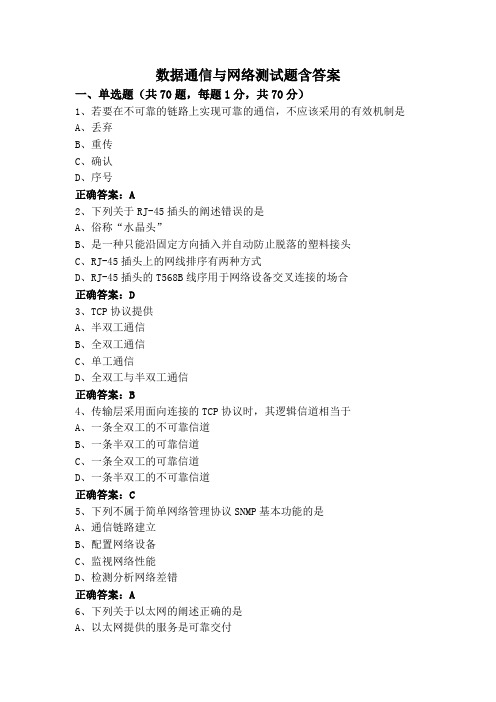
数据通信与网络测试题含答案一、单选题(共70题,每题1分,共70分)1、若要在不可靠的链路上实现可靠的通信,不应该采用的有效机制是A、丢弃B、重传C、确认D、序号正确答案:A2、下列关于RJ-45插头的阐述错误的是A、俗称“水晶头”B、是一种只能沿固定方向插入并自动防止脱落的塑料接头C、RJ-45插头上的网线排序有两种方式D、RJ-45插头的T568B线序用于网络设备交叉连接的场合正确答案:D3、TCP协议提供A、半双工通信B、全双工通信C、单工通信D、全双工与半双工通信正确答案:B4、传输层采用面向连接的TCP协议时,其逻辑信道相当于A、一条全双工的不可靠信道B、一条半双工的可靠信道C、一条全双工的可靠信道D、一条半双工的不可靠信道正确答案:C5、下列不属于简单网络管理协议SNMP基本功能的是A、通信链路建立B、配置网络设备C、监视网络性能D、检测分析网络差错正确答案:A6、下列关于以太网的阐述正确的是A、以太网提供的服务是可靠交付B、以太网的物理结构是星型C、以太网采用无连接方式D、以太网发送数据是组播方式正确答案:C7、IP数据报的最大长度(含首部)为A、576字节B、258字节C、1500字节D、65535字节正确答案:D8、信噪比常用表示为A、对数B、指数C、倒数D、平均数正确答案:A9、下列关于奇偶校验的阐述正确的是A、出错码元个数是奇数或偶数都有效B、传送的数据信息分组码元中“1”的个数为奇数C、奇偶校验的检错概率只有50%D、ISO规定在同步传输系统中采用偶校验正确答案:C10、关于信道和电路的阐述正确的是A、信道是电路的物理部件B、一条通信电路只包含一条发送信道或一条接收信道C、信道和电路是两个相同的概念D、信道是用来表示某一个方向传送信息的媒体正确答案:D11、模拟数据在一段时间内具有的值是A、不确定的B、固定的C、连续的D、离散的正确答案:C12、波分复用的本质是A、频分复用B、码分复用C、时分复用D、混合复用正确答案:A13、争用访问技术是一种A、无冲突的访问技术B、随机访问技术C、集中控制技术D、环访问技术正确答案:B14、下列对于理想的传输条件描述正确的是A、出现差错时可以重传B、需要采取有效措施保证数据传输可靠C、不管发送端以何种速率发送数据接收端都来得及处理所接收到的数据D、传输信道可能会引起差错正确答案:C15、一条消息所荷载的信息量等于它所表示的事件发生概率p的A、对数的平方B、倒数的对数C、对数的倒数D、倒数的平方正确答案:B16、以太网提供的服务是A、具有差错帧重传机制B、可靠的交付C、差错纠正由本层来决定D、不可靠的交付正确答案:D17、在公开密钥密码体制中,关于加密密钥与解密密钥的阐述正确的是A、解密密钥和解密算法是公开的B、加密密钥和解密密钥是保密信息C、解密密钥和解密算法是保密的D、加密密钥和加密算法是公开信息正确答案:D18、下列关于根域名服务器的阐述正确的是A、根域名服务器是最重要、最高层次的的域名服务器。
数据通信与计算机网络习题答案(邢彦辰)_课后习题答案

数据通信与计算机网络习题答案(邢彦辰)_课后习题答案数据通信与计算机网络习题参考答案第1章计算机网络概述一、填空题1(计算机、通信2(FEP、CCP3(数据通信、资源共享、分布式处理和均衡负荷、提高安全可靠性4(资源、通信5(ARPA6(电路交换、报文交换、分组交换7(局域网、城域网、广域网8(总线、星型、树型、环型、网状二、选择题1(D 2(C 3(A 4(A 5(B 6(B三、判断题1(× 2(? 3(? 4(×四、简答题1((1)面向终端的计算机网络;(2)多主机互联的网络阶段;(3)开放式标准化计算机网络阶段;(4)网络互连与高速网络阶段2(计算机网络是利用通信设备和线路把地理上分散的多台具有独立功能的计算机系统连接起来,在功能完善的网络软件支持下,进行数据通信,实现资源共享、互操作和协同工作的系统。
3((1)完成了对计算机网络的定义、分类与子课题研究内容的描述;(2)提出了资源子网、通信子网的两级网络结构的概念;(3)研究了报文分组交换的数据交换方法;(4)采用了层次结构的网络体系结构模型与协议体系;(5)促进了 TCP/IP 协议的发展。
4(虽然各种类型的计算机网络组成结构、具体用途和信息传输方式等不尽相同,但是它们却具有一些共同的特点。
主要体现在可靠性、独立性、高效性、扩充性、透明性、可控性和廉价性等几个方面。
5(典型的计算机网络在逻辑上可分为两个子网,是由资源子网和通信子网构成的,资源子网负责信息处理,通信子网负责全网中的信息传递。
资源子网由主机、用户终端、终端控制器、联网外部设备、各种软件资源与信息资源组成。
通信子网由专用的通信控制处理机CCP、通信线路与其它通信设备组成。
6((1)主体设备;(2)联接设备;(3)预处理设备;(4)信道。
7((1)按照网络的数据交换方式划分,主要的交换方法有电路交换网、报文交换、分组交换、帧中继交换网、ATM交换网和混合交换网;(2)按照网络的覆盖范围划分,可分为局域网、城域网和广域网;(3)按照网络的物理信道媒体划分,可分为双绞线网络、同轴电缆网络、光纤网络、微波网络、卫星网络等;按网络的拓扑结构划分,可分为总线型网络、环形型网络、星型网络、树型网络和网状型网络等;(5)按照网络应用范围和管理性质划分,可分为公用网和专用网两大类。
数据通信与计算机网络课后答案(浙江大学出版社)

《数据通信与计算机网络》部分课后习题答案第五章1、谈谈无线局域网采用的传输技术有哪些?答:无线局域网主要采用三种传输技术:1)跳频扩频FHSS2)直接序列扩频DSSS3)红外线技术2、简述WLAN的隐蔽站和暴露站问题,这两个问题说明了无线局域网的什么特点,可采用什么方法解决?答:隐蔽站问题:指无线节点没能检测出信道上已经存在的信号而导致冲突发生。
暴露站问题:在WLAN中,在不发生干扰的前提下允许多个节点进行通信,因检测出信道上已经存在的信号而放弃无冲突的通信。
说明了无线局域网的冲突检测确认难度很大,需采用冲突避免来解决这个问题,具体的就是采用信道预约CSMA/CA技术。
第六章1、谈谈电路交换和分组交换的区别及其优缺点。
答:(1)电路交换:在通信之前要在通信双方之间建立一条被双方独占的物理通路。
优点:传输数据的时延非常小。
实时性强。
不存在失序问题。
控制较简单。
缺点:电路交换的平均连接建立时间长。
信道利用低。
(2)分组交换:分组交换采用存储转发传输方式,但将一个长报文先分割为若干个较短的分组,然后把这些分组(携带源、目的地址和编号信息)逐个地发送出去.优点:加速了数据在网络中的传输。
简化了存储管理。
减少了出错机率和重发数据量。
缺点:仍存在存储转发时延。
增加了处理的时间,使控制复杂,时延增加。
2、什么是复用?复用技术有哪几种?答:复用技术:在一个物理链路上建立多个信道,每个信道具有固定的带宽,相互之间互不干涉。
复用技术主要包括:频分复用,时分复用,波分复用,码分多址等。
第八章1、(a)A,(b)C,(c)A2、(a)是,(b)否,(c)是3、进行子网划分后,网络号包含了子网号,因此本题的网络号为:192.168.5.1204、I和II可成为该主机的默认路由5、主机号为46、域名解析的功能:将域名翻译为对应IP 地址。
域名解析的方式有两种:递归解析和迭代解析。
8、ARP的作用是:在本地网内根据IP地址获取对应的MAC地址的一种映射关系。
- 1、下载文档前请自行甄别文档内容的完整性,平台不提供额外的编辑、内容补充、找答案等附加服务。
- 2、"仅部分预览"的文档,不可在线预览部分如存在完整性等问题,可反馈申请退款(可完整预览的文档不适用该条件!)。
- 3、如文档侵犯您的权益,请联系客服反馈,我们会尽快为您处理(人工客服工作时间:9:00-18:30)。
CHAPTER 20Network Layer: Internet ProtocolSolutions to Odd-Numbered Review Questions and ExercisesReview Questions1.The delivery of a frame in the data link layer is node-to-node. The delivery of apacket at the network layer is host-to-host.3.Each data link layer protocol has a limit on the size of the packet it can carry.When a datagram is encapsulated in a frame, the total size of the datagram must beless than this limit. Otherwise, the datagram must be fragmented. IPv4 allowsfragmentation at the host and any router; IPv6 allows fragmentation only at thehost.5.Options can be used for network testing and debugging. We mentioned sixoptions: no-operation, end-of-option, record-route, strict-source-route, loose-source-route, and timestamp. A no-operation option is a 1-byte option used as afiller between options. An end-of-option option is a 1-byte option used for paddingat the end of the option field. A record-route option is used to record the Internetrouters that handle the datagram. A strict-source-route option is used by thesource to predetermine a route for the datagram. A loose-source-route option issimilar to the strict source route, but it is less rigid. Each router in the list must bevisited, but the datagram can visit other routers as well. A timestamp option isused to record the time of datagram processing by a router.7.In IPv4, priority is handled by a field called service type (in the early interpreta-tion) or differential services (in the latest interpretation). In the former interpreta-tion, the three leftmost bits of this field define the priority or precedence; in thelatter interpretation, the four leftmost bits of this field define the priority. In IPv6,the four-bit priority field handles two categories of traffic: congestion-controlledand noncongestion-controlled.9.The checksum is eliminated in IPv6 because it is provided by upper-layer proto-cols; it is therefore not needed at this level.12Exercises11.If no fragmentation occurs at the router, then the only field to change in the baseheader is the time to live field. If any of the multiple-byte options are present, thenthere will be changes in the option headers as well (to record the route and/ortimestamp). If fragmentation does occur, the total length field will change toreflect the total length of each datagram. The more fragment bit of the flags fieldand the fragmentation offset field may also change to reflect the fragmentation. Ifoptions are present and fragmentation occurs, the header length field of the baseheader may also change to reflect whether or not the option was included in thefragments.13.Advantages of a large MTU:■ Good for transferring large amounts of data over long distances■ No fragmentation necessary; faster delivery and no reassembly■ Fewer lost datagrams■ More efficient (less overhead)Advantages of a small MTU:■ Good for transferring time-sensitive data such as audio or video■ Better suited for multiplexing15.The value of the header length field of an IP packet can never be less than 5because every IP datagram must have at least a base header that has a fixed size of20 bytes. The value of HLEN field, when multiplied by 4, gives the number ofbytes contained in the header. Therefore the minimum value of this field is 5. Thisfield has a value of exactly 5 when there are no options included in the header.17.If the size of the option field is 20 bytes, then the total length of the header is 40bytes (20 byte base header plus 20 bytes of options). The HLEN field will be thetotal number of bytes in the header divided by 4, in this case ten (1010 in binary).19.Since there is no option information, the header length is 20, which means that thevalue of HLEN field is 5 or 0101 in binary. The value of total length is 1024 + 20or 1044 (00000100 00010100 in binary).21.If the M (more) bit is zero, this means that the datagram is either the last fragmentor the it is not fragmented at all. Since the offset is 0, it cannot be the last fragmentof a fragmented datagram. The datagram is not fragmented.23.Let us first find the value of header fields before answering the questions:VER= 0x4 = 4HLEN =0x5 = 5 → 5 × 4 = 20Service =0x00 = 0Total Length = 0x0054 = 84Identification = 0x0003 = 3Flags and Fragmentation = 0x0000 → D = 0 M= 0 offset = 0Time to live = 0x20 = 32Protocol= 0x06 = 63 Checksum = 0x5850Source Address: 0x7C4E0302 = 124.78.3.2Destination Address: 0xB40E0F02 = 180.14.15.2We can then answer the questions:a.If we calculate the checksum, we get 0x0000. The packet is not corrupted.b.Since the length of the header is 20 bytes, there are no options.c.Since M = 0 and offset = 0, the packet is not fragmented.d.The total length is 84. Data size is 64 bytes (84 −20).e.Since the value of time to live = 32, the packet may visit up to 32 more routers.f.The identification number of the packet is 3.g.The type of service is normal.4。
